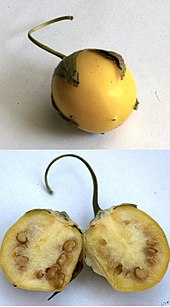
Datura is a genus of nine species of highly poisonous, vespertine-flowering plants belonging to the nightshade family (Solanaceae). They are commonly known as thornapples or jimsonweeds, but are also known as devil's trumpets. Other English common names include moonflower, devil's weed, and hell's bells. All species of Datura are extremely poisonous and psychoactive, especially their seeds and flowers, which can cause respiratory depression, arrhythmias, fever, delirium, hallucinations, anticholinergic syndrome, psychosis, and death if taken internally.
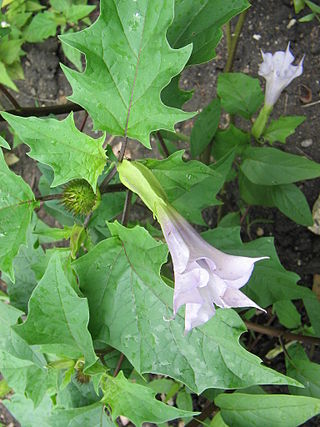
Datura stramonium, known by the common names thorn apple, jimsonweed, devil's snare, or devil's trumpet, is a poisonous flowering plant of the nightshade family Solanaceae. It is a species belonging to the Datura genus and Daturae tribe. Its likely origin was in Central America, and it has been introduced in many world regions. It is an aggressive invasive weed in temperate climates and tropical climates across the world. D. stramonium has frequently been employed in traditional medicine to treat a variety of ailments. It has also been used as a hallucinogen, taken entheogenically to cause intense, sacred or occult visions. It is unlikely ever to become a major drug of abuse owing to effects upon both mind and body frequently perceived as being highly unpleasant, giving rise to a state of profound and long-lasting disorientation or delirium with a potentially fatal outcome. It contains tropane alkaloids which are responsible for the psychoactive effects, and may be severely toxic.

Atropa is a genus of flowering plants in the nightshade family, Solanaceae: tall, calcicole, herbaceous perennials, bearing large leaves and glossy berries particularly dangerous to children, due to their combination of an attractive, cherry-like appearance with a high toxicity. Atropa species favour temperate climates and alkaline soils, often growing in light shade in woodland environments associated with limestone hills and mountains. Their seeds can remain viable in the soil for long periods, germinating when the soil of sites in which plants once grew is disturbed by human activity or by natural causes, e.g. the windthrow of trees. The best-known member of the genus Atropa is deadly nightshade - the poisonous plant par excellence in the minds of many. The pharmacologically active ingredients of Atropa species include atropine, scopolamine, and hyoscyamine, all tropane alkaloids having anticholinergic, deliriant, antispasmodic and mydriatic properties. The genus is named for Άτροπος (Atropos) - lit. 'she who may not be turned (aside)' - one of the Three Fates and cutter of the thread of life / bringer of death - in reference to the extreme toxicity of A.belladonna and its fellow species - of which four others are currently accepted.

Atropa belladonna, commonly known as belladonna or deadly nightshade, is a toxic perennial herbaceous plant in the nightshade family Solanaceae, which also includes tomatoes, potatoes and aubergine (Eggplant). It is native to Europe and Western Asia, including Turkey. Its distribution extends from Ireland in the west to western Ukraine and the Iranian province of Gilan in the east. It is also naturalised or introduced in some parts of Canada, North Africa and the United States.

A besom is a broom, a household implement used for sweeping. The term is mostly reserved for a traditional broom constructed from a bundle of twigs tied to a stout pole. The twigs used could be broom, heather or similar. The song "Buy Broom Buzzems" from Northern England refers to both types of twig. From the phrase broom besom the more common broom comes. In Scotland, besoms are still occasionally to be found at the edge of forests where they are stacked for use in early response to an outbreak of fire.
Mandrake is a poisonous herbaceous plant in the genus Mandragora, often connected with magical rituals.

Brugmansia is a genus of seven species of flowering plants in the nightshade family Solanaceae. They are woody trees or shrubs, with pendulous flowers, and have no spines on their fruit. Their large, fragrant flowers give them their common name of angel's trumpets, adjacent to the nickname devil's trumpets of the closely related genus Datura.
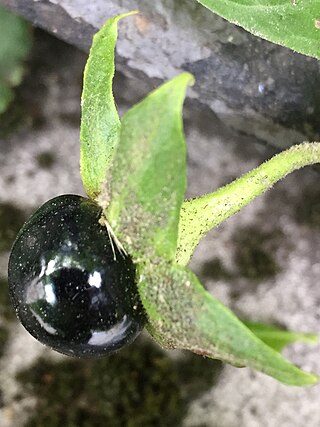
Deliriants are a subclass of hallucinogen. The term was coined in the early 1980s to distinguish these drugs from psychedelics such as LSD and dissociatives such as ketamine, due to their primary effect of causing delirium, as opposed to the more lucid and less disturbed states produced by other types of hallucinogens. The term generally refers to anticholinergic drugs, which are substances that inhibit the function of the neurotransmitter acetylcholine. Common examples of deliriants include plants of the genera Datura and Brugmansia as well as higher than recommended dosages of diphenhydramine (Benadryl). A number of plant deliriants such as that of the Solanaceae family, particularly in the Americas have been used by some indigenous cultures to reach delirious and altered states for traditions or rituals, such as rites of passage, divination or communicating with the ancestors. Despite their long history of use, deliriants are the least-studied class of hallucinogens in terms of their behavioral and neurological effects.

Mandragora officinarum is the type species of the plant genus Mandragora in the nightshade family Solanaceae. It is often known as mandrake, although this name is also used for other plants. As of 2015, sources differed significantly in the species they use for Mandragora plants native to the Mediterranean region. The main species found around the Mediterranean is called Mandragora autumnalis, the autumn mandrake. In a broader circumscription, all the plants native to the regions around the Mediterranean Sea are placed in M. officinarum, which thus includes M. autumnalis. The names autumn mandrake and Mediterranean mandrake are then used. Whatever the circumscription, Mandragora officinarum is a perennial herbaceous plant with ovate leaves arranged in a rosette, a thick upright root, often branched, and bell-shaped flowers followed by yellow or orange berries.
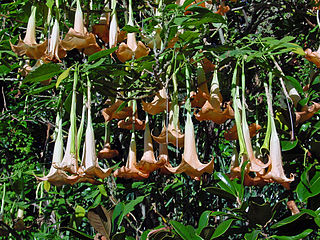
Brugmansia versicolor is a species of plant in the family Solanaceae, commonly known as “angel’s trumpets”. They are endemic to Ecuador. Since March 2014, they have been listed as Extinct in the Wild by the IUCN.

Tropane alkaloids are a class of bicyclic [3.2.1] alkaloids and secondary metabolites that contain a tropane ring in their chemical structure. Tropane alkaloids occur naturally in many members of the plant family Solanaceae. Certain tropane alkaloids such as cocaine and scopolamine are notorious for their psychoactive effects, related usage and cultural associations. Particular tropane alkaloids such as these have pharmacological properties and can act as anticholinergics or stimulants.

Brugmansia sanguinea, the red angel's trumpet, is a species of South American flowering shrub or small tree belonging to the genus Brugmansia in tribe Datureae of subfamily Solanoideae of the nightshade family Solanaceae. It has been cultivated and used as an entheogen for shamanic purposes by the South American Natives for centuries - possibly even millennia.

Mandragora is a plant genus belonging to the nightshade family (Solanaceae). Members of the genus are known as mandrakes. Between three and five species are placed in the genus. The one or two species found around the Mediterranean constitute the mandrake of ancient writers such as Dioscorides. Two or three further species are found eastwards into China. All are perennial herbaceous plants, with large tap roots and leaves in the form of a rosette. Individual flowers are bell-shaped, whitish through to violet, and followed by yellow or orange berries.

A mandrake is the root of a plant, historically derived either from plants of the genus Mandragora found in the Mediterranean region, or from other species, such as Bryonia alba or the American mandrake which have similar properties. The plants from which the root is obtained are also called "mandrakes". Mediterranean mandrakes are perennial herbaceous plants with ovate leaves arranged in a rosette, a thick upright root, often branched, and bell-shaped flowers followed by yellow or orange berries. They have been placed in different species by different authors. They are highly variable perennial herbaceous plants with long thick roots and almost no stem. The leaves are borne in a basal rosette, and are variable in size and shape, with a maximum length of 45 cm (18 in). They are usually either elliptical in shape or wider towards the end (obovate), with varying degrees of hairiness.
Mandragora turcomanica, the Turkmenian mandrake, is a perennial herbaceous plant in the family Solanaceae, native to the Köpet Dag mountains in Turkmenistan and one location in neighbouring Iran. It differs from the mandrakes found around the Mediterranean chiefly by being larger.
Mandragora caulescens, the Himalayan mandrake, is a perennial herbaceous plant in the family Solanaceae, native to the Himalayas and mountainous regions of Myanmar and south-west China. One of the differences from the other species of Mandragora is that it has a stem, whereas they are stemless. Like all species of Mandragora, it contains tropane alkaloids, making it toxic. It is used in traditional Chinese medicine.

The Solanaceae, or the nightshades, are a family of flowering plants that ranges from annual and perennial herbs to vines, lianas, epiphytes, shrubs, and trees, and includes a number of agricultural crops, medicinal plants, spices, weeds, and ornamentals. Many members of the family contain potent alkaloids, and some are highly toxic, but many—including tomatoes, potatoes, eggplant, bell and chili peppers—are used as food. The family belongs to the order Solanales, in the asterid group and class Magnoliopsida (dicotyledons). The Solanaceae consists of about 98 genera and some 2,700 species, with a great diversity of habitats, morphology and ecology.
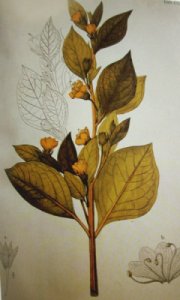
Atropa baetica, commonly known as the Andalusian belladonna, is one of Europe's rarest wildflowers. A close relative of the infamous deadly nightshade, its specific name derives from that of the Roman province of Hispania Baetica, while its common name refers to the Spanish region of Andalucía – both designating the area in the south of Spain where it is most frequently encountered. It is an attractive perennial plant with a herbaceous habit, bearing infundibuliform, yellow or greenish flowers and shiny, black berries. Like the other three species of Atropa, it is an extremely poisonous plant, containing a variety of tropane alkaloids with anticholinergic, deliriant, antispasmodic and mydriatic properties. Although most populations of the plant are to be found in Spain, it is not wholly confined to the Iberian Peninsula of Europe, occurring also in certain localities in Morocco and Algeria in the Atlas Mountains of North Africa. The Rif and the Baetic System, which face each other across the Alboran Sea, together constitute one of the finest of the Mediterranean biodiversity hotspots – rich in endemic species, of which Atropa baetica is a notable example..


